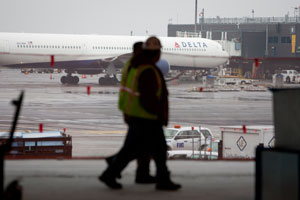JFK Upgrade Spurs Backlash Over Moving Freight Upstate

Governor Andrew Cuomo’s plan to make New York’s John F. Kennedy International Airport more passenger-friendly by cutting out most cargo facilities risks backfiring, a shipping-industry group and analysts say.
Shippers say moving any part of the industry will wreck a business that carries 1.3 million tons of goods through JFK annually, making it the seventh-largest U.S. cargo airport.
“If there’s a big push for this, there will be a huge shift in the cargo transport in and out of the New York area and it would result in a huge hit to the economy,” said Brandon Fried, who heads the Airforwarders Association in Washington, a group representing almost 400 companies that coordinate shipping by air, truck, rail and ship.
“There will be one big political fight to stop it.” Cuomo, a 56-year-old Democrat facing re-election, wants to spruce up the gateway to the largest U.S. city by adding hotel rooms, conference space and dining options. He says it will boost the economy by making New York more desirable to vacationers and businesses. To make room, he would move most freight facilities to Stewart International Airport, 70 miles north of Manhattan.
JFK, along with LaGuardia Airport and Newark Liberty International in New Jersey, served 54 million departing passengers and handled one-third of the nation’s flights last year. JFK feeds a shipping industry that accounts for 50,000 jobs, $3 billion in wages and $8.5 billion in sales for the metro region, according to a 2013 report funded by the Port Authority of New York and New Jersey and the city’s economic development corporation.
Cuomo took over management of the Port Authority’s renovations of the city airports this year. The agency, which runs LaGuardia and JFK, is allocating $8 billion to construction at the two facilities and Newark in the next 10 years. That includes $2.2 billion as part of a $3.6 billion redesign of LaGuardia’s 50-year-old central terminal, voted America’s dirtiest and most poorly designed by readers of Travel & Leisure magazine in 2012.
The governor last week announced a contest with a $500,000 prize for designers who submit plans that remake JFK and LaGuardia based on his goals.
Boosting capacity for air cargo isn’t just a U.S. issue. London’s Heathrow, Europe’s busiest airport, is already at its limits, crimping Prime Minister David Cameron’s push for more exports. Adding a third runway is controversial because the field is already enveloped by urban sprawl. Expanding Gatwick, London’s No. 2 airport, could dilute the benefits of a single hub that make more routes viable, the Confederation of British Industry says.
Cuomo’s idea to turn Stewart International in Newburgh into a cargo hub faces similar hurdles to those at Gatwick. In addition to there being more flights through JFK, the airport is surrounded by a concentration of customs brokers and freight forwarders. They control routing of most of the world’s international freight shipments, according to the 2013 report by Cincinnati-based consultant Landrum & Brown.
Under Cuomo’s plan, most of the cargo facilities would shift from JFK to Stewart in the Hudson Valley. He wants to create a tax-free zone around Stewart to attract the industry.
A day after Cuomo’s Oct. 20 announcement, investors perceived more risk in bonds issued to refinance two cargo buildings at JFK. The extra yield demanded by a buyer of bonds maturing in 2019 increased to 1.41 percentage points over benchmark debt from 1.14 percentage points on Sept. 9, according to data compiled by Bloomberg.
To be sure, JFK is a difficult place for shippers. The traffic-plagued Van Wyck Expressway impedes truck access to the airport. New York City also restricts the use of 53-foot tractor-trailers, which have become an industry standard, according to the 2013 report. Airport facilities should be modernized to make the airport more competitive, the report said. JFK’s cargo volume has declined 28% in the past decade, according to the Port Authority.
More than 50% of the cargo coming into JFK is in the belly of passenger planes, and Cuomo’s focus is on attracting “non-belly” cargo to Stewart, said Patrick Foye, the Port Authority’s executive director.
“The goal is to grow the cargo pie,” Foye said at an Oct. 22 press briefing in New York.
Kate Blumm, a spokeswoman for the New York City Economic Development Corp., declined to comment on Cuomo’s proposal.
Matt Anderson, a Cuomo spokesman, said that whatever Stewart gains doesn’t necessarily mean a loss for JFK.
“We are committed to ensuring that any longer-term changes would proceed in a way that preserves and ultimately expands overall jobs and economic development at JFK,” Anderson said in an e-mailed statement.
Shippers, however, rely on “network connectivity,” the ability of an airport to provide options to carry freight to the same destination, said Michael Webber, an Austin, Texas-based consultant who has worked for the Port Authority. That requires a combination of passenger jets and freight-only planes; the connectivity is what makes JFK attractive and Stewart, where there are far fewer flights, unattractive, he said by phone.
“Splitting operations between two airports would be catastrophic,” Webber said. “It would diminish the competitiveness of the main gateway, JFK, and by doing so diminish the competitiveness of the region itself.”




